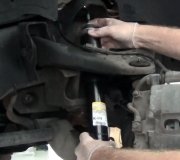Happy you asked. If you have access to a professional strut compressor, you have a couple of options. If you're doing this at home, most people use those hooks to compress the coil spring, and those are dangerous. As a suspension and alignment specialist at a new-car dealership, I preferred using an old clam-shell-type compressor, and even those can be dangerous. I saw a spring fly out and take out an eight-foot light fixture. I had one fly out and bounce all the way across the shop and out to the parking lot. It made so much noise, the office manager heard it from behind two closed doors, and came running out to see what was going on. Did I mention these are dangerous?
The better alternative, especially when you're doing this at home, is to buy a pair of "Quick Struts" that are ready to install. The car is going to need to be aligned when you're done, and a conscientious alignment specialist is going to measure ride height first. That is critical for proper tire wear and handling. If the coil springs are sagged from age, that changes the geometry of the suspension components, and that changes the range of movements the wheels go through as they move up and down on the road. We can still align the car, "for the rack", meaning the numbers on the computer will look perfect, but there will still be miserable tire wear on the road. The pre-assembled Quick Struts come with new coil springs which will restore correct ride height.
The upper strut mounts can also cause problems with noisy or hard turning, and in severe cases, the center hole can rust away and let the shaft of the strut wobble and change alignment. That wear can't be seen until the assembly is removed and taken apart. At that point you have to order new mounts, and the car is not driveable in the meantime. Those upper mounts are often a dealer-only item, and must be special-ordered. Since they come as part of the Quick Strut, you don't have to worry about them.
There are also hard rubber "strut cushions" on the shafts of the struts, and there may be dust boots attached to them. Either of those can break apart and rattle. Those are also special-order items. You definitely don't want to eliminate a cushion. Doing so will cause a real hard bump when going over big bumps in the road. This is most noticeable when crossing over a sidewalk at an angle, to enter a parking lot. The jolt is so bad, you WILL want to take everything apart again to install that missing cushion.
One last thing to be aware of is a few models, Chrysler products in particular, use a rubber insulator between the bottom of the coil spring and the plate on the strut body it sits on. Those are about 1/4" thick and have a metal stiffening member inside the rubber coating. Where rust and salt are common, that metal frame can rust away, then the rubber can squirt out. The problem is you won't notice that until you have the assembly apart, then you have to run to the dealer's parts department for new ones. In my case, the parts department had a sales history of "0", so they never stocked the part. I wasn't about to put everything back together, then tell the customer to come back days later for the same service, so I just put the new struts on and left those isolators off. (Other models used the same struts but without those isolators). It took a couple of years worth of repair orders before I convinced the parts department to stock those parts. Once they were in stock and available when I needed them in the middle of the job, the sales history shot up. If those were used as original equipment, they will be included with the Quick Struts too. If your car model didn't use them originally, but they are included with the new assemblies, they will only raise ride height about 1/4", which will still be in specs, and they will quiet the ride a little.
If you have never replaced struts before, it is a good idea to work alongside a mentor who can point out little details and hints.
Saturday, March 25th, 2017 AT 2:45 PM



